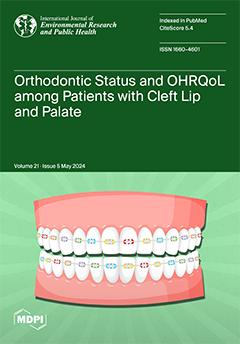Multimorbidity of malaria, anemia, and malnutrition (MAMM) is a condition in which an individual has two or more of these health conditions, and is becoming an emergent public health concern in sub-Saharan African countries. The independent associations of a child’s demographic variables and
[...] Read more.
Multimorbidity of malaria, anemia, and malnutrition (MAMM) is a condition in which an individual has two or more of these health conditions, and is becoming an emergent public health concern in sub-Saharan African countries. The independent associations of a child’s demographic variables and household socioeconomic (HSE) disparities with a child’s health outcomes have been established in the literature. However, the effects of the intersection of these factors on MAMM, while accounting for other covariates, have not been studied. Therefore, this study aimed to determine how children’s sex, age, and household socioeconomic status interact to explain the variations in MAMM among children aged 6–59 months in Nigeria. Data from the 2018 Nigeria Demographic and Health Survey and the 2018 National Human Development Report (NHDR) were used. This study included weighted samples of 10,184 children aged 6–59 months in Nigeria. A three-level multilevel mixed effect ordinal logistic regression model was used, such that individual characteristics at level 1 were nested in communities at level 2 and nested in states at level 3. Subsequently, predictive probability charts and average adjusted probability tables were used to interpret the intersectional effects. Five models were created in this scenario. Model 1 is the interaction between the child’s sex and household wealth status; model 2 is the interaction between the child’s sex and age; model 3 is the interaction between the child’s age and household wealth status; model 4 has the three two-way interactions of the child’s sex, age, and household wealth status; and model 5 includes model 4 and the three-way interactions between a child’s sex, age, and household wealth quintiles; while accounting for other covariates in each of the models. The prevalence of children with a ‘none of the three diseases’ outcome was 17.3% (1767/10,184), while 34.4% (3499/10,184) had ‘only one of the diseases’, and 48.3% (4918/10,184) had ‘two or more’ MAMMs. However, in the multivariate analyses, model 3 was the best fit compared with other models, so the two-way interaction effects of a child’s age and household wealth status are significant predictors in the model. Children aged 36–47 months living in the poorest households had a probability of 0.11, 0.18, and 0.32 of existing with MAMM above the probability of children of the same age who live in the middle class, more prosperous, and richest households, respectively, while all other covariates were held constant. Thus, the variation in the prevalence of MAMM in children of different ages differs depending on the household wealth quintile. In other words, in older children, the variations in MAMM become more evident between the richer and the poorer household quintiles. Therefore, it is recommended that policies that are geared toward economic redistribution will help bridge the disparities observed in the prevalence of multiple diseases among children aged 6–59 months in Nigeria.
Full article





